Exercycle Workouts: Your Ultimate Guide
An exercise bike, also knows as a stationary bike, is a great way to get a cardiovascular workout in the comfort of your own home. Not only does indoor cycling provide an efficient way to burn calories and improve cardiovascular health, but they are also low-impact and easy on the joints. This guide will provide you with everything you need to know to get started with stationary bike workouts.
Read on to find out the benefits of and correct use of stationary bikes, or jump straight to the workouts here.
What are the different types of Exercycles?
There are several different types of stationary bikes available on the market, each with their own unique features and capabilities. Some of the most common types of exercise bikes include:
- Upright Exercise Bikes: These are the most common type of exercise bike, and resemble a traditional bicycle. They have a vertical seat position, and the pedals are located directly underneath the seat. Upright bikes are great for a full-body workout and are suitable for all fitness levels.
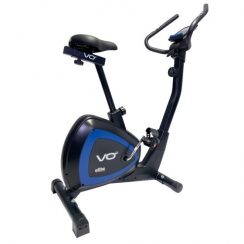 Recumbent Exercise Bikes. A recumbent bike has a more laid-back design, with a larger seat and a backrest. The pedals are located in front of the seat, and the rider sits in a semi-reclined position. Recumbent bikes are great for people with back or joint problems, as they offer more support and a lower-impact workout.
Recumbent Exercise Bikes. A recumbent bike has a more laid-back design, with a larger seat and a backrest. The pedals are located in front of the seat, and the rider sits in a semi-reclined position. Recumbent bikes are great for people with back or joint problems, as they offer more support and a lower-impact workout.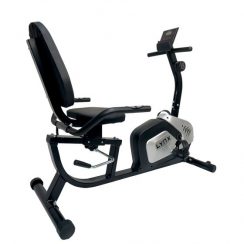 Spin Bikes: These bikes are designed to replicate the feeling of riding a road bike. They have a heavier flywheel, which provides resistance, and the rider sits in an upright position. Spin bikes are great for high-intensity workouts and are popular in spin classes.
Spin Bikes: These bikes are designed to replicate the feeling of riding a road bike. They have a heavier flywheel, which provides resistance, and the rider sits in an upright position. Spin bikes are great for high-intensity workouts and are popular in spin classes.
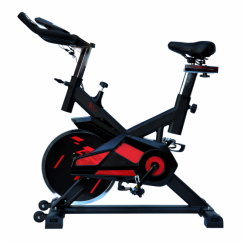
What are some Benefits of Stationary Bike Workouts?
Exercise bikes are a versatile and effective piece of equipment for anyone looking to improve their cardiovascular fitness. They provide a low-impact workout that is easy on the joints, making them a great option for people of all ages and fitness levels. In addition to improving cardiovascular health, regular exercise on an exercise bike can also help with weight loss, muscle tone, and overall health.
How Long Should I Workout on a Stationary Bike?
The duration of your stationary bike workout will depend on your fitness level and goals. The general consensus is at least 150 minutes of moderate-intensity aerobic activity or 75 minutes of vigorous-intensity aerobic activity per week, in addition to muscle-strengthening activities at least twice a week. Here are some general guidelines for stationary bike workout duration based on your fitness level:
Beginner: If you’re new to exercise or haven’t exercised in a while, start with shorter duration, such as 10-15 minutes, and gradually increase the duration over time. Aim to work up to 30 minutes of moderate-intensity exercise, 3-4 times per week.
Intermediate: If you’re already moderately fit, aim for 30-45 minutes of moderate-intensity exercise, 3-5 times per week.
Advanced: If you’re already in good shape, aim for 45-60 minutes of vigorous-intensity exercise, 3-5 times per week.
It’s important to note that, regardless of your fitness level, you should always warm up for 5-10 minutes before starting your workout and cool down for 5-10 minutes after your workout. Additionally, it’s important to increase the resistance level gradually as your fitness improves.
It’s also important to remember that exercise is just one aspect of a healthy lifestyle and that the duration of exercise is not the only important aspect, but also the intensity and frequency. It’s always good to consult with a physician before starting any new exercise routine, especially if you have any pre-existing medical conditions or injuries.
Are Exercise Bikes Good for Weight Loss? Can they Build Strength?
Exercise bikes can be an effective tool for weight loss and building strength.
- Weight Loss: Exercise bikes can be an effective way to burn body fat. tool for weight loss because they provide a cardiovascular workout that can burn a significant amount of calories. The number of calories burned during a workout will depend on factors such as the intensity of the workout, the duration of the workout, and the individual’s weight. By burning calories through exercise, you can create a calorie deficit which can lead to weight loss.
- Building Strength: Exercise bikes can help to build strength in the lower body, specifically the legs. The resistance of the pedals provides a workout for the quadriceps, hamstrings, and calf muscles. Additionally, some exercise bikes come with adjustable resistance levels, so you can increase the resistance as you get stronger. By using the high resistance level, you can work your muscles harder and build more strength.
It’s important to note that while exercise bikes can be a great tool for weight loss and building strength, they should be used in conjunction with a healthy diet and other forms of exercise. A combination of strength training and cardio exercise is the best approach to maintain a healthy weight, improve cardiovascular fitness, and build muscle.
Setting Up the Bike
Before you begin your workout, it’s important to adjust the seat height and handlebar position to ensure that the bike is properly fitted to your body. The seat should be adjusted so that your knees are slightly bent when the pedals are at their lowest point. The handlebars should be adjusted so that they are at a comfortable height for your arms and shoulders.
Choose the right resistance level, based on your fitness level. Start with a lower resistance and gradually increase as your fitness improves. It’s also important to make sure that the bike is level and stable before you begin your workout.
Warm-Up
Warming up before exercising is essential to prepare your muscles for the workout ahead and to reduce your risk of injury. Before you begin your exercise bike workout, spend 5-10 minutes doing a light warm-up such as jogging in place or doing jumping jacks. This will help to increase your heart rate and get your blood flowing.
Workout 1: Beginner Workout
This beginner workout is designed for those who are new to exercise or just starting out with an exercise bike. It features a low to high resistance progression that gradually increases the difficulty of the workout, helping you to build up your stamina and strength. The heart rate target is set at 130-140 BPM, which is a moderate intensity that is appropriate for a beginner.

Workout 2: Intermediate Workout
This intermediate workout is designed for those who have been exercising regularly and are ready to step up the intensity of their workout. The resistance levels progress from medium to very high, providing a challenging workout that will help to improve your strength and cardiovascular fitness. The heart rate target is set at 140-150 BPM, which is a high intensity that is appropriate for an intermediate user.

Workout 3: Advanced Workout
This advanced workout is designed for those who have a high level of fitness and are looking for a challenging workout. The resistance levels are set at high to maximum, providing a strenuous workout that will test your limits. The heart rate target is set at 150-160 BPM, which is a very high intensity that is appropriate for an advanced user. This workout is not recommended for those who are new to exercise or just starting out with an exercise bike.

It’s important to note that these are just examples and you should adjust the time, resistance level, and heart rate target based on your own fitness level and goals. It’s also important to consult with a physician before starting any new exercise routine, especially if you have any pre-existing medical conditions or injuries.
Cool Down
Just like warming up is important, it’s also important to cool down after exercising. This will help to gradually decrease your heart rate and prevent blood from pooling in your legs. Spend 5-10 minutes doing a light cool-down such as stretching or walking.
Target Heart Rate
Cardiovascular Training plays an important part in maintaining a healthy heart and lung function, so it’s no surprise we should be paying attention to how quickly our heart beats during exercise. There are different heart rate training zones determined by the individual’s age and workout goals to ensure you train safely and effectively.
Before starting any workout regimen, it’s important to know what your target heart rate should be. Different types of workouts are performed at different intensities, or workout zones.
Target heart rates are a percentage of your theoretical maximum heart rate and can help ensure that you’re neither working too hard nor not hard enough. By working out your theoretical maximum heart rate, you can figure out the target ranges and zones for different types of workouts.
How to Calculate Your Maximum Heart Rate.
A very simple method to find out your target heart rate, take your age and subtract it from 220. That number will be your maximum heart rate. From there, you can use the following formulas to calculate your target heart rate:
220 – AGE = TMHR (Theoretical Maximum Heart Rate in beats per minute)
TMHR x 85% = (Upper Training Limit) bpm (Beats per Minute)
TMHR x 65% = (Lower Training Limit) bpm
Example:
If you’re 39 years old, your max heart rate would be:
220 – 39 = 181 bpm
85% of this would be the upper limit for most workouts, while 65% would be the lower limit:
181 x 85% (0.85) = 154 bpm and 181 x 65% (0.65) = 118 bpm
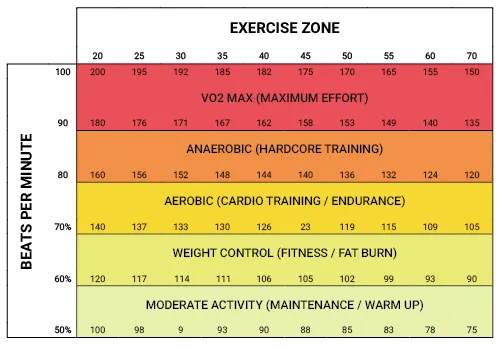
Remember, these are just guidelines. You may need to adjust based on how you’re feeling during your workout. If you’re working at a moderate intensity but don’t feel like you’re breaking a sweat, you may need to bump up the intensity. Similarly, if you’re working at a vigorous intensity but feel like you’re about to collapse, you may need to back off a bit.
How to measure your heart rate during exercise
Your heart rate can be measured by using the radial (wrist) or carotid (neck) pulse using your index and middle fingers, counting the beats for 10 seconds and multiplying by 6.
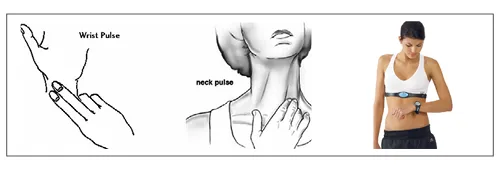
Many sports watches will incorporate a heart rate monitor that utilises an optical sensor to calculate your heart rate from blood flow. Accuracy will vary by device and conditions but can give you a good estimate. Chest heart rate straps will give you the most accurate reading, as these measure the electrical signals from your heart.
Cardiovascular Training plays an important part in maintaining a healthy heart and lung function, so it’s no surprise we should be paying attention to how quickly our heart beats during exercise. The chart below outlines a range of heart rate training zones determined by the individual’s age and workout goals to ensure you train safely and effectively.
Written by Elite Fitness Team,
Updated February 2023